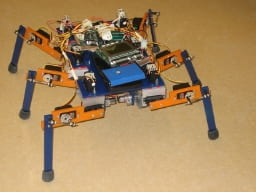 |
|||

The development of a new family of robotic vehicles for use in the exploration of remote planetary surfaces, such as Mars, and remote sites on Earth, such as Antartica, is an ongoing process. Current robotic vehicles must traverse rough terrain having various characteristics such as steep slopes, icy surfaces, and cluttered rock distributions, to name a few. The goal of the Byrobot project is to design a new robotic mobility system that performs to optimum capability in remote environments, which leads to the idea of the Legged-Wheeled robot. Science exploration in unknown and uncharted terrain involves operating in an unstructured and poorly modeled environment. Several designs are plausible for operating in these types of environments. In order to guarantee success of robotic missions for the future, technologies that can enable multi-rover collaboration and human-robot interaction must be matured. The main hurdle with this focus is the cost and system complexity associated with deploying multiple robotic vehicles having the capability to survive long periods of time, as well as possessing multi-tasking capability. To address this issue, this research focuses on modularizing both hardware and software components to create a reconfigurable robotic explorer. The new Legged-Wheeled design robot possesses wheels, as well as Field mobile robots must traverse long distances on hazardous terrain safely and autonomously using uncertain and imprecise information. Research such as traversability analysis, deliberative path planning with pre-stored terrain maps and embedded reactive behavior have been used to address the problems of navigation in natural terrain, but the process of successfully navigating between two designated points in rough terrain with minimal human interaction is still an open issue. Legged robots, versus wheeled mobility platforms, offers many advantages due to their ability to traverse a wide variety of terrain, but the control of walking poses special challenges in natural environments. Even simple legged-robot platforms have a large degree of coupled interactions and no single walking gait is suitable for all terrain surfaces. Walking surfaces can vary in a number of factors including traction properties, hardness, frictional coefficients, and bearing strength. To successfully operate within varying terrain environments, an automatic gait adaptation method for field mobile robots is a desirable quality. The focus of our work is therefore on the development of a methodology that learns new walking gaits autonomously while operating in an uncharted environment, such as on the Mars planetary surface or in the remote Antarctica environment. |
|||
| About | Perception and Reasoning | Human-System Interaction | Space and Field Robotics | People | Home | |||
<![CDATA[
]]>

